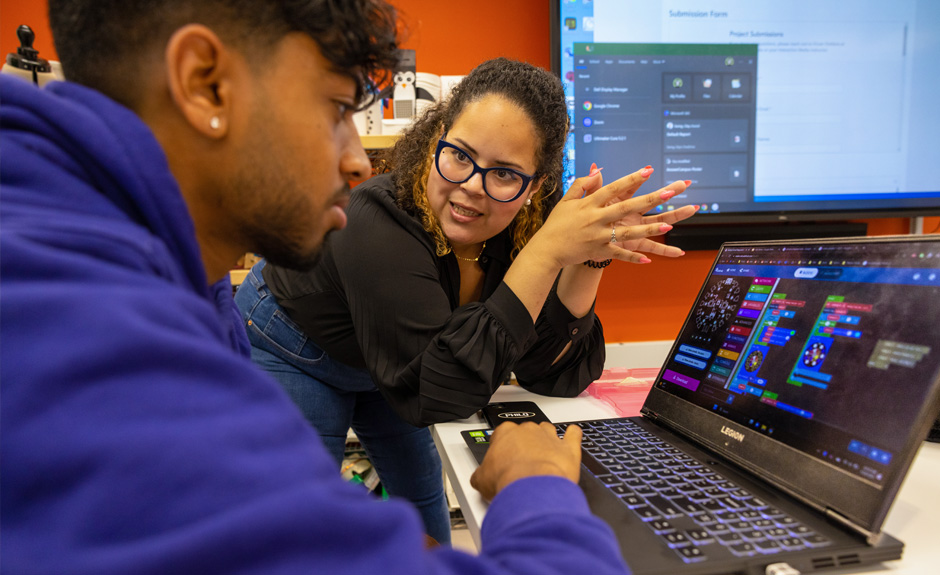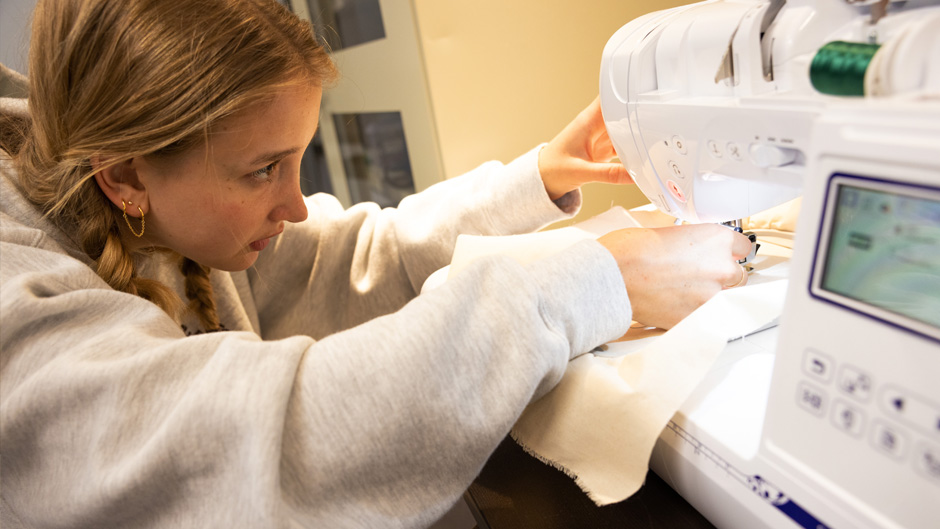The clock struck 10:45 a.m. during Lorena Lopez’s “Wearable Technologies” class last week. Though the period had concluded for the day, not a single student enrolled in the new course budged from their seats. So enthralled with the work they were doing, the time continued to pass as students intricately sewed coded circuit boards into their fabrics, preparing for their final projects.
Among those projects are a sleeping sweater that plays music when the lights dim; an outdoor jacket that notes GPS location to help hikers stay safe; and a shirt that notifies you when you slouch by illuminating in different colors.
As technology continues to evolve, Lopez, a lecturer in the University of Miami School of Communication’s interactive media program, noted that the current landscape of design courses needs to expand past screen-based technologies. That is when she decided to create a new course that focuses on on the intersection of design for the real world, where physical and digital experiences, and how they are seamlessly integrated through technologies that can be worn.
“In product design, we're heading into extended reality technologies, but we still exist in the real world. So, I always think about how we can add technology that lives in this physical plane and can create a real connection between the physical and the digital worlds that we’re creating,” Lopez said.

In the new special topics class, students engage in a three-part curriculum during a single semester, learning how to create wearable technologies. The course begins with the history of wearable tech, including examples and applications of integrated technology in everyday life.
Then, Lopez teaches students how to create these pieces from scratch—from how to sew fabrics, the coding of the microcontrollers, how to identify where the technology can be integrated, the construction of their wearable circuits, and finally the creation of their wearable prototype.
“It’s important for students to understand how garments are made, how materials react to stress, and how pattern pieces fit together. That way, they can better understand how they’re going to build the technology into their garment, and design better wearable circuits with the user in mind,” Lopez said.
During the semester, students have access to a range of materials and tools, including sensors, microcontrollers, sewing machines, 3D printers, embroidery machines, and laser cutters to help them bring their ideas to life.
By using small circuit boards about two inches in diameter, students code the devices that respond to audio cues, pressure, and temperature to create outputs such as playing music, or flashing colored LEDs.
Lopez encourages students to think outside of the box in identifying where technology could enhance an everyday wearable item and to approach design challenges with a fresh perspective, hoping to create a culture of innovation and creativity.
“I wanted students to start thinking of what else can you see, what else can you sense, what can we create, what can we listen to, and see what kind of story you can tell with the data through your wearable,” Lopez said.
Bianca Matthews, a senior studying interactive media, pulled inspiration from a music festival and created a leg wrap that illuminated as she danced to the beat of a song.
“We learned how to use sewable LED lights, conductive thread, and fabric, and I programmed it to respond to a certain amount of force and pressure from a foot stomp with a color,” Matthews said. “I had mine play an animation. So, as you’re dancing, you’re lighting up.”
For her final project, Matthews created a dress modeled after Dorothy from “The Wizard of Oz.” The garment uses fiber-optic cables that transforms from black and white to a radiant blue at the click of a red ruby heel.
“This class is my favorite thing I’ve done. I love the combination of the programming and the tech side of it, as well as the creative and hardware side of [the projects],” she said. Though the student had no previous experience in creating garments, she now envisions pursuing a career that integrates her knowledge of coding and physical computing with wearable clothes—much like a Walt Disney imagineer, she said.
For senior Annia Lopez, the class appealed to her interest in fashion. Though she had no experience in computing, the student works for her family fashion company soldering luxury bridal headpieces and has enjoyed learning how to incorporate technology into creative design work. The class has even made her consider how to incorporate technology into her headpieces.
“Part of the beauty of the class is that we all come from different backgrounds and with different interests, so we’re all creating really different projects,” she said. “It’s like ‘wow,’ when I see what we’re making.”
The students will showcase their final designs during the Interactive Media Annual Showcase on Tuesday, May 2, at 3 p.m. in the Koenigsberg & Nadal Interactive Media Center at the School of Communication.

